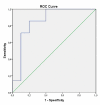Relationship Between Pituitary Siderosis and Endocrinological Disorders in Pediatric Patients with Beta-Thalassemia
- PMID: 33633906
- PMCID: PMC7899051
- DOI: 10.7759/cureus.12877
Relationship Between Pituitary Siderosis and Endocrinological Disorders in Pediatric Patients with Beta-Thalassemia
Abstract
Introduction Excess iron accumulation occurs mainly in organs such as reticuloendothelial cells, the pituitary gland, and the pancreas in beta-thalassemia because of blood transfusions. In the present study, it was aimed to investigate the relationship between T2* values on magnetic resonance imaging (MRI) and clinically diagnosed pituitary endocrinological disorders in children with thalassemia major. Methods This study enrolled patients diagnosed with beta-thalassemia at pediatric hematology outpatient clinics. In the study, in addition to the medical history of the patients, routinely performed tests, including hemoglobin electrophoresis, routine biochemical tests, and tests for pubertal development (follicle-stimulating hormone (FSH), luteinizing hormone (LH), estradiol, testosterone, etc.), as well as iron deposition measured by hepatic MRI T2* (STAR) sequence, were retrospectively assessed. A total of 29 patients were enrolled. Results Hypothyroidism was detected in 34.6% (9/26) of patients, short stature in 37% (10/27), and pubertal retardation in 50% (14/28) of the patients. There was no significant correlation between hypothyroidism and pituitary MRI T2* values. No significant correlation was found between laboratory parameters and pituitary MRI examination. Although the sensitivity of T2* levels could rise above 80%, their specificity remained low. This is one of the major limitations of the pituitary MR T2* study for the prediction of short stature. The best lower cut-off level of MR T2* to predict short stature was found 14.6 ms. Conclusion The diagnostic specificity pituitary MR examination levels for short stature were detected as low. Thus, the clinical standardization and validation of pituitary MR T2* values examination are needed before clinical follow-up and multifaceted studies are needed.
Keywords: beta thalassemia; pituitary mri; siderosis; t2.
Copyright © 2021, Yılmaz et al.
Conflict of interest statement
The authors have declared that no competing interests exist.
Figures
Similar articles
-
MRI of the liver and the pituitary gland in patients with beta-thalassemia major: does hepatic siderosis predict pituitary iron deposition?Eur Radiol. 2003 Jan;13(1):12-6. doi: 10.1007/s00330-002-1421-3. Epub 2002 May 1. Eur Radiol. 2003. PMID: 12541105
-
Utility of MRI in assessment of pituitary iron overload.J Pak Med Assoc. 2007 Sep;57(9):475-7. J Pak Med Assoc. 2007. PMID: 18072648
-
T2 relaxation rate as an index of pituitary iron overload in patients with beta-thalassemia major.AJR Am J Roentgenol. 2000 Dec;175(6):1567-9. doi: 10.2214/ajr.175.6.1751567. AJR Am J Roentgenol. 2000. PMID: 11090376
-
Prevalence of growth and puberty failure with respect to growth hormone and gonadotropins secretion in beta-thalassemia major.Arch Iran Med. 2006 Oct;9(4):329-34. Arch Iran Med. 2006. PMID: 17061604
-
MRI-based evaluation of the factors leading to pituitary iron overload in patients with thalassemia major.J Neuroradiol. 2016 Jul;43(4):297-302. doi: 10.1016/j.neurad.2016.03.001. Epub 2016 Apr 12. J Neuroradiol. 2016. PMID: 27083690
Cited by
-
Cross-sectional study on the impact of cardiac and hepatic iron overload, as measured by MRI T2*, on the quality of life in children with severe beta-thalassemia major.Medicine (Baltimore). 2024 Jul 5;103(27):e38817. doi: 10.1097/MD.0000000000038817. Medicine (Baltimore). 2024. PMID: 38968493 Free PMC article.
-
GH/IGF-1 axis in a large cohort of ß-thalassemia major adult patients: a cross-sectional study.J Endocrinol Invest. 2022 Jul;45(7):1439-1445. doi: 10.1007/s40618-022-01780-z. Epub 2022 Mar 19. J Endocrinol Invest. 2022. PMID: 35305249 Free PMC article.
-
[Monitoring and interventions of growth disorders and endocrine function in children with transfusion-dependent thalassemia].Zhongguo Dang Dai Er Ke Za Zhi. 2025 Apr 15;27(4):389-394. doi: 10.7499/j.issn.1008-8830.2501080. Zhongguo Dang Dai Er Ke Za Zhi. 2025. PMID: 40241355 Free PMC article. Review. Chinese.
References
-
- Pathophysiology of thalassaemia. Weatherall DJ. Baillieres Clin Haematol. 1998;11:127–146. - PubMed
-
- Survival and complications in thalassemia. Borgna-Pignatti C, Cappellini MD, Stefano DEP, et al. Ann NY Acad Sci. 2005;1054:40–47. - PubMed
-
- Incidence of endocrine complications and clinical disease severity related to genotype analysis and iron overload in patients with beta-thalassaemia. Jensen CE, Tuck SM, Old J, et al. Eur J Haematol. 1997;59:76–81. - PubMed
-
- Reproductive health in young male adults with chronic diseases in childhood. De Sanctis V, Soliman A, Mohamed Y. https://pubmed.ncbi.nlm.nih.gov/23724436/ Pediatr Endocrinol Rev. 2013;10:284–296. - PubMed
LinkOut - more resources
Full Text Sources
Other Literature Sources

